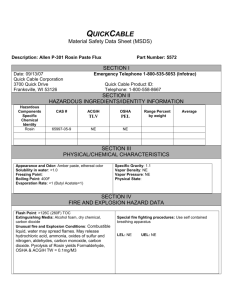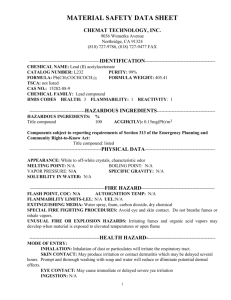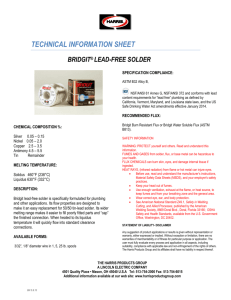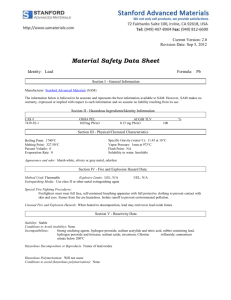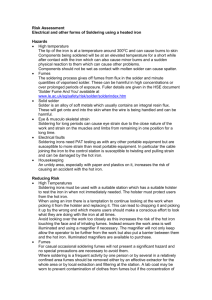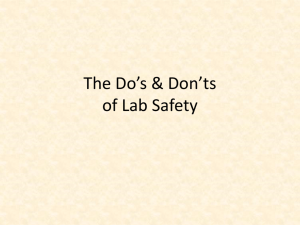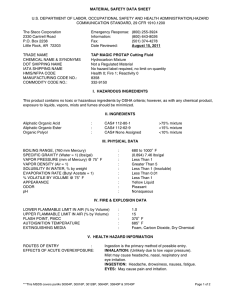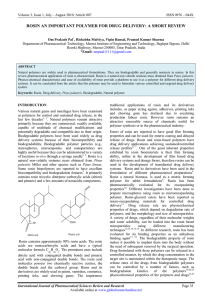Safety Data Sheet according to (EC) No 1907/2006 CP 60EN 362 5C
advertisement
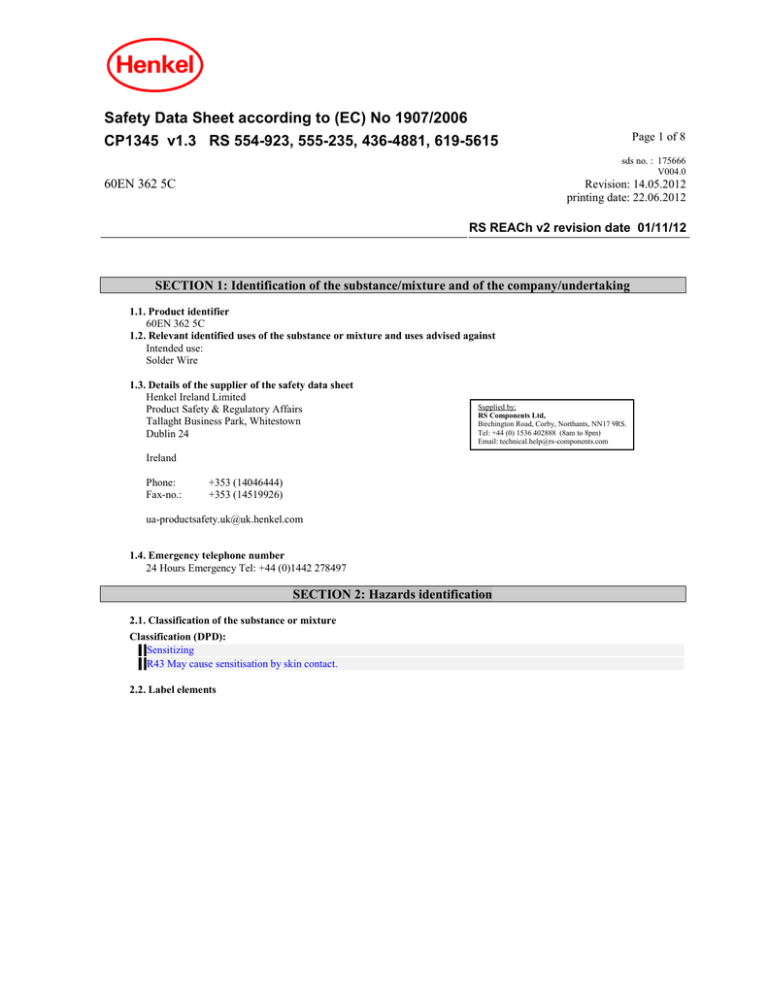
Safety Data Sheet according to (EC) No 1907/2006 CP v1. RS , Page 1 of 8 sds no. : 175666 V004.0 60EN 362 5C Revision: 14.05.2012 printing date: 22.06.2012 RS REACh v2 revision date 01//12 SECTION 1: Identification of the substance/mixture and of the company/undertaking 1.1. Product identifier 60EN 362 5C 1.2. Relevant identified uses of the substance or mixture and uses advised against Intended use: Solder Wire 1.3. Details of the supplier of the safety data sheet Henkel Ireland Limited Product Safety & Regulatory Affairs Tallaght Business Park, Whitestown Dublin 24 Supplied by: RS Components Ltd, Birchington Road, Corby, Northants, NN17 9RS. Tel: +44 (0) 1536 402888 (8am to 8pm) Email: technical.help@rs-components.com Ireland Phone: Fax-no.: +353 (14046444) +353 (14519926) ua-productsafety.uk@uk.henkel.com 1.4. Emergency telephone number 24 Hours Emergency Tel: +44 (0)1442 278497 SECTION 2: Hazards identification 2.1. Classification of the substance or mixture Classification (DPD): Sensitizing R43 May cause sensitisation by skin contact. 2.2. Label elements CP v1. RS , MSDS-No.: 175666 V004.0 Page 2 of 8 60EN 362 5C Label elements (DPD): Xi - Irritant Risk phrases: R43 May cause sensitisation by skin contact. Safety phrases: S24 Avoid contact with skin. S37 Wear suitable gloves. S23 Do not breathe fumes. Contains: Rosin 2.3. Other hazards Fumes evolved at soldering temperatures will irritate the nose, throat and lungs. Prolonged or repeated exposure to flux fumes may result in sensitisation in sensitive workers. Regulations forbid the use of lead solder in any private or public drinking water supply system. SECTION 3: Composition/information on ingredients Declaration of the ingredients according to CLP (EC) No 1272/2008: Hazardous components CAS-No. Tin 7440-31-5 EC Number REACH-Reg No. 231-141-8 01-2119486474-28 content Classification Lead 7439-92-1 231-100-4 01-2119513221-59 >= 30- < 40 % No data available. Rosin 8050-09-7 232-475-7 >= 1- < 5 % Skin sensitizer 1 H317 >= 50- < 60 % For full text of the H - statements and other abbreviations see section 16 "Other information". Substances without classification may have community workplace exposure limits available. Declaration of ingredients according to DPD (EC) No 1999/45: Hazardous components CAS-No. Tin 7440-31-5 EC Number REACH-Reg No. 231-141-8 01-2119486474-28 content Lead 7439-92-1 231-100-4 01-2119513221-59 >= 30 - < 40 % Rosin 8050-09-7 232-475-7 >= 1 - < 5 % Classification >= 50 - < 60 % For full text of the R-Phrases indicated by codes see section 16 'Other Information'. Substances without classification may have community workplace exposure limits available. R43 CP v1. RS , MSDS-No.: 175666 V004.0 60EN 362 5C Page 3 of 8 SECTION 4: First aid measures 4.1. Description of first aid measures Inhalation: Move to fresh air. If symptoms persist, seek medical advice. Skin contact: Rinse with running water and soap. Obtain medical attention if irritation persists. Eye contact: Flush eyes with plenty of water for at least 5 minutes. If irritation persists seek medical attention. Ingestion: Do not induce vomiting. Seek medical advice. 4.2. Most important symptoms and effects, both acute and delayed Flux fumes may irritate the nose, throat and lungs and may after prolonged/repeated exposure give an allergic reaction (asthma). SKIN: Rash, Urticaria. 4.3. Indication of any immediate medical attention and special treatment needed See section: Description of first aid measures SECTION 5: Firefighting measures 5.1. Extinguishing media Suitable extinguishing media: Carbon dioxide, foam, powder Extinguishing media which must not be used for safety reasons: Do not use water on fires where molten metal is present. 5.2. Special hazards arising from the substance or mixture High temperatures may produce heavy metal dust, fumes or vapours. The flux medium will give rise to irritating fumes. 5.3. Advice for firefighters Wear self-contained breathing apparatus. SECTION 6: Accidental release measures 6.1. Personal precautions, protective equipment and emergency procedures Wear protective equipment. 6.2. Environmental precautions Do not empty into drains / surface water / ground water. 6.3. Methods and material for containment and cleaning up Scrape up spilled material and place in a closed container for disposal. 6.4. Reference to other sections See advice in chapter 8 SECTION 7: Handling and storage CP v1. RS , MSDS-No.: 175666 V004.0 Page 4 of 8 60EN 362 5C 7.1. Precautions for safe handling Extraction is necessary to remove fumes evolved during reflow. When using do not eat, drink or smoke. Wash hands before breaks and immediately after handling the product. Avoid breathing fumes given out during soldering. See advice in chapter 8 Hygiene measures: Good industrial hygiene practices should be observed. Do not eat, drink or smoke while working. After handling solder wash hands with soap and water before eating, drinking or smoking. 7.2. Conditions for safe storage, including any incompatibilities Ensure good ventilation/extraction. Store in a cool, dry place. 7.3. Specific end use(s) Solder Wire SECTION 8: Exposure controls/personal protection 8.1. Control parameters Valid for Great Britain Ingredient ppm TIN (INORGANIC COMPOUNDS AS SN) 7440-31-5 INORGANIC LEAD AND ITS COMPOUNDS 7439-92-1 LEAD AND ITS IONIC COMPOUNDS 7439-92-1 LEAD AND LEAD COMPOUNDS, OTHER THAN LEAD ALKYLS (AS PB) 7439-92-1 ROSIN-BASED SOLDER FLUX FUME 8050-09-7 ROSIN-BASED SOLDER FLUX FUME 8050-09-7 mg/m3 2 0,15 Type Time Weighted Average (TWA): Time Weighted Average (TWA): Category Indicative Remarks ECTLV EU_OEL Biological Limit Value: EU_OEL_II 0,15 Time Weighted Average (TWA): EH40 WEL 0,05 Time Weighted Average (TWA): Short Term Exposure Limit (STEL): EH40 WEL 0,15 EH40 WEL Colophony (Rosin) and derivatives: Rosin-based flux fume as total resin acids. 8.2. Exposure controls: Engineering controls: Extraction is necessary to remove fumes evolved during reflow. Where reasonably practicable this should be achieved by the use of local exhaust ventilation and good general extraction. Ensure good ventilation/extraction. Respiratory protection: Ensure adequate ventilation. An approved mask or respirator fitted with an organic vapour cartridge should be worn if the product is used in a poorly ventilated area In case of aerosol formation, we recommend wearing of appropriate respiratory protection equipment with ABEK P2 filter. This recommendation should be matched to local conditions. Hand protection: Please note that in practice the working life of chemical resistant gloves may be considerably reduced as a result of many influencing factors (e.g. temperature). Suitable risk assessment should be carried out by the end user. If signs of wear and tear are noticed then the gloves should be replaced. The use of chemical resistant gloves such as Nitrile are recommended. Eye protection: Safety glasses with sideshields or chemical safety goggles should be worn if there is a risk of splashing. CP v1. RS , MSDS-No.: 175666 V004.0 Page 5 of 8 60EN 362 5C Skin protection: Wear suitable protective clothing. SECTION 9: Physical and chemical properties 9.1. Information on basic physical and chemical properties Appearance solid grey None Odor pH Initial boiling point Flash point Decomposition temperature Vapour pressure Density (20 °C (68 °F)) Bulk density Viscosity Viscosity (kinematic) Explosive properties Solubility (qualitative) Solidification temperature Melting point Flammability Auto-ignition temperature Explosive limits Partition coefficient: n-octanol/water Evaporation rate Vapor density Oxidising properties not applicable Not determined not applicable No data available / Not applicable No data available / Not applicable 8,5 g/cm3 No data available / Not applicable No data available / Not applicable No data available / Not applicable No data available / Not applicable Insoluble No data available / Not applicable 183,0 - 188,0 °C (361.4 - 370.4 °F) No data available / Not applicable No data available / Not applicable No data available / Not applicable Not applicable No data available / Not applicable No data available / Not applicable No data available / Not applicable 9.2. Other information No data available / Not applicable SECTION 10: Stability and reactivity 10.1. Reactivity Solder alloy will react with concentrated nitric acid to produce toxic fumes of nitrogen oxides. Reacts with strong oxidants. 10.2. Chemical stability Stable under recommended storage conditions. 10.3. Possibility of hazardous reactions See section reactivity 10.4. Conditions to avoid No decomposition if stored and applied as directed. 10.5. Incompatible materials None if used properly. 10.6. Hazardous decomposition products Thermal decomposition can lead to release of irritating gases and vapors. CP v1. RS , MSDS-No.: 175666 V004.0 Page 6 of 8 60EN 362 5C SECTION 11: Toxicological information 11.1. Information on toxicological effects General toxicological information: The preparation is classified based on the conventional method outlined in Article 6(1)(a) of Directive 1999/45/EC. Relevant available health/ecological information for the substances listed under Section 3 is provided in the following. Oral toxicity: This material is considered to have low toxicity if swallowed. Inhalative toxicity: Fumes evolved at soldering temperatures will irritate the nose, throat and lungs. Prolonged or repeated exposure to flux fumes may result in sensitisation in sensitive workers. Dermal toxicity: May cause sensitization by skin contact. Skin irritation: Fumes emitted during soldering may irritate the skin. Eye irritation: Fumes emitted during soldering may irritate the eyes. SECTION 12: Ecological information General ecological information: The preparation is classified based on the conventional method outlined in Article 6(1)(a) of Directive 1999/45/EC. Relevant available health/ecological information for the substances listed under Section 3 is provided in the following. Ecotoxicity: May cause long-term adverse effects in the aquatic environment. Mobility: The product is insoluble and sinks in water. Bioaccumulative potential: Octanol/Water distribution coefficient: Not applicable 12.1. Toxicity Hazardous components CAS-No. Value type Value Exposure time Species Method > 1.000 mg/l Acute Toxicity Study Fish Rosin 8050-09-7 LC50 96 h Pimephales promelas EC50 911 mg/l Daphnia 48 h Daphnia magna OECD Guideline 203 (Fish, Acute Toxicity Test) OECD Guideline 202 (Daphnia sp. Acute Immobilisation Test) Rosin 8050-09-7 Rosin 8050-09-7 EC50 > 100 mg/l Algae 72 h Scenedesmus subspicatus (new name: Desmodesmus subspicatus) 12.2. Persistence and degradability Hazardous components CAS-No. Rosin 8050-09-7 Result Route of application aerobic Degradability Method 36 - 46 % OECD Guideline 301 F (Ready Biodegradability: Manometric Respirometry Test) CP v1. RS , MSDS-No.: 175666 V004.0 Page 7 of 8 60EN 362 5C SECTION 13: Disposal considerations 13.1. Waste treatment methods Product disposal: Wherever possible unwanted solder alloy should be recycled for recovery of metal. Otherwise dispose of in accordance with local and national regulations. Disposal of uncleaned packages: Dispose of as unused product. Waste code 16 03 03 - inorganic wastes containing dangerous substances SECTION 14: Transport information General information: Not hazardous according to RID, ADR, ADNR, IMDG, IATA-DGR. SECTION 15: Regulatory information 15.1. Safety, health and environmental regulations/legislation specific for the substance or mixture VOC content <1% National regulations/information (Great Britain): Remarks The Health & Safety at Work Act 1974. The Control of Lead at Work Regulations. L132:Control of Lead at Work: Approved Code of Practice and Guidance. The Control of Substances Hazardous to Health Regulations. L5:General Approved Code of Practice to the COSHH Regulations. HS(G)97:A Step by Step Guide to the COSHH Regulations. HS(G)193:COSHH essentials: Easy steps to control chemicals. IND (G)248L:Solder fume and you. IND(G)249L:Controlling health risks from rosin (colophony) based solder fluxes. Employees should be under medical surveillance if the risk assessment made under the Control of Lead at Work Regulations indicates they are likely to be exposed to significant concentrations of lead, or if an Employment Medical Advisor or appointed doctor so certifies. A woman employed on work which exposes her to lead should notify her employer as soon as possible if she becomes pregnant. The Employment Medical Advisor / Appointed Doctor should be informed of the pregnancy. Under the Management of Health and Safety at Work Regulations, employers are required to assess the particular risks to health at work of pregnant workers and workers who have recently given birth or who are breast feeding. CP v1. RS , MSDS-No.: 175666 V004.0 60EN 362 5C Page 8 of 8 SECTION 16: Other information The labelling of the product is indicated in Section 2. The full text of all abbreviations indicated by codes in this safety data sheet are as follows: R43 May cause sensitisation by skin contact. H317 May cause an allergic skin reaction. Further information: This information is based on our current level of knowledge and relates to the product in the state in which it is delivered. It is intended to describe our products from the point of view of safety requirements and is not intended to guarantee any particular properties. This safety data sheet was prepared in accordance with Council Directive 67/548/EEC and it's subsequent amendments, and Commission Directive 1999/45/EC.
